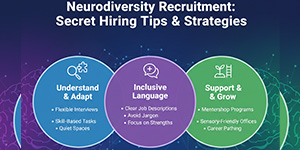Top 10 HR Trends to Watch in 2025: The Future of Work is Here
As we move deeper into the digital age, HR trends 2025 are rethinking how companies handle workplace culture, talent attracting employees, employee retention, and people management.
The workforce's evolving expectations, the ongoing transition to remote and hybrid work environments, and new developments in technology are all rewriting the traditional HR playbook.
In this article, we explore the top 10 HR trends 2025 that every business leader, organizational strategists and human resources professionals need to be knowledgeable in order to keep themselves competitive.
1. AI-Powered Recruitment and Talent Acquisition
HR trends 2025 are being heavily influenced by artificial intelligence. AI-driven tools now screen resumes, conduct preliminary interviews, and assess candidate fit using predictive analytics.
Step-by-Step Guide to Implementing AI in Hiring:
- Choose an AI-enabled applicant tracking system (ATS).
- Train the system on your company’s hiring data.
- Create custom filters based on role requirements.
- Continuously refine and audit the AI's performance.
Use Case: A software business in Bangalore saw a 40% decrease in their hiring cycle after implementing an AI-based resume screening system.
Use Case: A Singaporean healthcare organization improved the caliber of its applicants by using AI to match interpersonal abilities to team dynamics.
2. Hybrid Work Models Become Standard
The rise of hybrid work isn't just a COVID-19 response, it's now a permanent fixture among the latest trends in HR. Businesses are revamping their work policies to allow for both in-person and remote work options also.
Steps to Transition into a Hybrid Model:
- Audit job roles for remote feasibility.
- Invest in remote collaboration tools.
- Set clear expectations and communication protocols.
- Offer training for virtual leadership.
Use Case: A multinational company in Germany increased productivity by 25% by converting 60% of its employees to hybrid setups.
Use Case: When flexible working days were implemented, employee satisfaction at an Indian e-commerce company increased by 30%.
3. Upskilling and Reskilling Initiatives
One of the current HR trends and challenges is closing the gap in skills. With the speed at which technology is developing, lifelong learning is now required.
Steps to Create a Skills Development Program:
- Conduct a skills gap analysis.
- Partner with e-learning platforms.
- Allocate time during work hours for training.
- Reward certifications and learning milestones.
Use Case: A financial services company launched a “Learn in 30” program allowing employees to learn new skills in 30-minute daily sessions.
Use Case: A Cambodian startup partnered with Coursera to offer free certifications increasing employee retention by 18%.
4. Emphasis on Employee Well-being
Well-being is now a strategic focus rather than a fringe benefit. This shift is central to employee engagement trends in HR trends 2025.
The first step in incorporating wellness programs is to provide mental health services like coaching and therapy.
- Present habit-tracking wellness applications.
- Monthly wellness challenges should be created.
- Benefits that are health-oriented (yoga sessions, nutritious snacks, etc.).
Use Case: A BPO in the Philippines introduced a mindfulness app for employees, which led to a 12% drop in sick days.
Use Case: A remote tech team in the US offered free fitness memberships and saw a 35% increase in productivity.
5. Diversity, Equity, and Inclusion (DEI) as a Business Strategy
Better team performance, innovation and retention are observed in organizations that place a higher priority on DEI. It's an important element of future HR trends 2025.
Steps to Drive DEI:
- Set measurable DEI goals.
- Conduct bias training for all levels.
- Revamp hiring practices to be more inclusive.
- Regularly audit company culture.
Use Case: By providing targeted mentorship, a global fashion firm raised the number of women in leadership positions by 40%.
Use Case: By implementing anonymous resume screening, an IT company in Cambodia increased minority employment by 20%.
6. Data-Driven HR Decision Making
With the proliferation of people analytics, HR departments are making smarter, faster and more accurate decisions also.
The first step in utilizing people analytics is to determine the most important KPIs, such as engagement score and retention rate.
- Employ technology for HR to monitor and display data.
- Analyze patterns and take action on new information.
- KPIs should be reviewed and updated often.
Use Case: A logistics firm reduced turnover by 22% after identifying burnout trends in employee data.
Use Case: An HR consultancy used predictive analytics to forecast hiring needs for a client three quarters in advance.
7. Agile Performance Management
Traditional annual reviews are being replaced with real-time feedback systems. This is one of the current HR trends 2025 and challenges companies face.
Steps to Build an Agile Performance Culture:
- Switch from yearly to quarterly or monthly reviews.
- Use 360-degree feedback tools.
- Set short-term, measurable goals.
- Provide coaching-based leadership training.
Use Case: OKRs (Objectives and Key Results) were used by a financial firm which accelerated team alignment.
Use Case: A media organization increased transparency and morale by implementing biweekly one-on-ones.
8. Gamification of Workplace Engagement
Turning work tasks and learning into games is one of the most well-liked HR trends 2025 for employee engagement.
How to Put Gamification into Practice:
- Select a gamification software that works with your HR systems also.
- Provide transparent incentive structures.
- Use leaderboards and badges.
- Keep the system optional but incentivized.
Use Case: A call center used gamification to motivate attendance and saw a 50% reduction in absenteeism.
Use Case: A software firm gamified their training process, resulting in a 3x increase in module completion rates.
9. Tech-Enabled Onboarding Experiences
Seamless onboarding is becoming critical in recent trends in talent management, especially with remote teams.
Steps for Better Onboarding:
- Use onboarding software (like BambooHR or Gusto).
- Automate document signing and training schedules.
- Assign mentors or onboarding buddies.
- Collect feedback after the onboarding process.
Use Case: A company that prioritizes remote work developed a virtual onboarding program that reduced the time it took for new hires to ramp up by half.
Use Case: To increase return rates for the upcoming season, a hotel chain onboarded seasonal employees using a mobile app.
10. Rise of Fractional HR and Gig-Based Expertise
Because of their flexibility and experience more businesses are turning to gig-based HR consultants or fractional CHROs as a result of the rapid changes in company requirements. How Fractional HR Is Used: Identify any specialized or short-term HR needs. Employers can find verified HR freelancers on these networks and use contracts with clear deliverables and ensure knowledge transfer before project end.
Use Case: For setting up their whole HR policy in three months, a startup employed a fractional HR consultant.
Use Case: During the busiest hiring season an NGO cut expenses by 35% by using gig-based recruiters.
Read More: How to Become an HR Business Partner: Skills, Resume Tips & Career Guide
Conclusion
The HR trends 2025 are not just predictions, they are shaping the fabric of the modern workplace trends. Every trend from gamification to AI and from hybrid work to well-being highlights the increasing significance of tech-savvy human-centered HR procedures.
In this new age of labor, companies who adjust quickly will prosper while those that continue to use antiquated models run the risk of falling behind. Stay ahead of the curve by keeping a close eye on these latest trends in HR, and leverage them to create more dynamic, inclusive, and resilient workplaces.
Read More: Recruitment Trends in Cambodia: Job Market and Hiring Landscape





